Uncertainty Quantification Analysis of Exhaust Gas Plume in a Crosswind
Abstract
:1. Introduction
2. Numerical Model
2.1. Governing Equations
2.2. CFD Model
2.3. Validation
3. Uncertainty Quantification Models
3.1. Surrogate-Based Sampling Method
3.2. Polynomial Chaos Expansion Method
4. UQ Analysis: Uncertainty on Exhaust Gas Outlet Velocity vf
4.1. Sensitivity Analysis of vf
4.2. UQ Analysis of vf: Surrogate-Based Approach
4.3. UQ Analysis of vf: Polynomial Chaos Approach
5. UQ Analysis: Uncertainty on Incoming Wind Angle α
5.1. Sensitivity Analysis of Wind Direction α
5.2. UQ Analysis of α: Surrogate-Based Approach
5.3. UQ Analysis of α: Polynomial Chaos Approach
6. Conclusions
Author Contributions
Funding
Data Availability Statement
Conflicts of Interest
Nomenclature
| A | Surface area |
| h | Enthalpy |
| k | Turbulent kinetic energy |
| m | Average |
| p | Static pressure |
| R | Velocity ratio |
| t | Time |
| T | Temperature |
| u | Velocity |
| vf | Velocity magnitude at chimney exit |
| V | Crossflow velocity |
| y+ | Non dimensional boundary layer distance from wall |
| α | Wind angle in the horizontal plane with respect to the normal crossflow |
| ε | Rate of dissipation of turbulent kinetic energy |
| μ | Viscosity |
| ρ | Density |
| σ | Standard deviation |
| τ | Tensor of tangential and normal stress |
| Subscript | |
| t | Total |
| Acronyms | |
| ANN | Artificial Neural Network |
| CFD | Computer Fluid Dynamics |
| DNS | Direct Numerical Simulation |
| DoEs | Design of Experiments |
| LES | Large Eddy Simulation |
| LHS | Latin Hypercube Sampling |
| MC | Monte Carlo |
| MLE | Maximum Likelihood Estimation |
| NIPC | Non-Intrusive Polynomial Chaos |
| PCEs | Polynomial Chaos Expansions |
| QoI | Quantities of Interest |
| RANS | Reynolds-averaged Navier–Stokes |
| RBF | Radial Basis Function |
| RSM | Reynolds stress model |
| SB | Surrogate-Based approach |
| UQ | Uncertainty Quantification |
References
- Gary, J.B.; Mc Cullum, D. Stack Design Technology for Naval and Merchant Ships. SNAME Trans. 1977, 85, 324–349. [Google Scholar]
- Kulkarni, P.R.; Singh, S.N.; Seshadri, V. A study of Smoke Nuisance Problem on Ships—A Review. Int. J. Mar. Eng. Proc. R. Inst. Nav. Archit. Part A2 2005, 147, 27–50. [Google Scholar]
- Morton, B.R.; Taylor, G.I.; Turner, J.S. Turbulent gravitational convection from maintained and instantaneous sources. Proc. R. Soc. Lond. A 1956, 234, 1–23. [Google Scholar]
- Slawson, P.R.; Csanady, G.T. The effects of atmospheric conditions on plume rise. J. Fluid Mech. 1976, 47, 33–49. [Google Scholar] [CrossRef]
- Briggs, G.A. Plume Rise Predictions; AMS Workshop on Meteorology and Environmental Assessment: Boston, MA, USA, 1975. [Google Scholar]
- Schatzmann, M. An integral model of plume rise. Atmos. Environ. 1979, 13, 721–731. [Google Scholar] [CrossRef]
- Weil, J.C.; Brower, R.P. An Updated Gaussian Plume Model for Tall Stacks. J. Air Pollut. Control. Assoc. 1984, 34, 818–827. [Google Scholar] [CrossRef]
- Alton, B.W.; Davidson, G.A.; Slawson, P.R. Comparison of measurements and integral model predictions of hot water plume behaviour in a crossflow. Atmos. Environ. 1993, 27, 589–598. [Google Scholar] [CrossRef]
- Muldoon, F.; Acharya, S. Direct Numerical Simulation of pulsed jets-in-crossflow. Comput. Fluids 2010, 39, 1745–1773. [Google Scholar] [CrossRef]
- Hargreaves, D.M.; Scase, M.M.; Evans, I. A simplified computational analysis of turbulent plumes and jets. Environ. Fluid Mech. 2012, 12, 555–578. [Google Scholar] [CrossRef]
- König, C.S.; Mokhtarzadeh-Dehghan, M.R. Numerical study of buoyant plumes from a multi-flue chimney released into an atmospheric boundary layer. Atmos. Environ. 2002, 36, 3951–3962. [Google Scholar] [CrossRef]
- Saïd, N.M.; Mhiri, H.; Le Palec, G.; Bournot, P. Experimental and numerical analysis of pollutant dispersion from a chimney. Atmos. Environ. 2005, 39, 1727–1738. [Google Scholar]
- Shah, S.B.H.; Zahir, S.; Lu, X.Y. Numerical Simulations of Morphology, Flow Structures and Forces for a Sonic Jet Exhausting in Supersonic Crossflow. J. Appl. Fluid Mech. 2012, 5, 39–47. [Google Scholar]
- Xing, J.; Liu, Z.; Huang, P.; Feng, C.; Zhou, Y.; Zhang, D.; Wang, F. Experimental and numerical study of the dispersion of carbon dioxide plume. J. Hazard. Mater. 2013, 256, 40–48. [Google Scholar] [CrossRef]
- Oliveira, R.F.; Ferreira, A.C.; Teixeira, S.F.; Teixeira, J.C.; Marques, H.C. pMDI spray plume analysis: A CFD study. In Proceedings of the World Congress on Engineering, London, UK, 3–5 July 2013; Volume 3, pp. 1–6. [Google Scholar]
- Jatale, A.; Smith, P.J.; Thornock, J.N.; Smith, S.T.; Spinti, J.P.; Hradisky, M. Application of a verification, validation and uncertainty quantification framework to a turbulent buoyant helium plume. Flow Turbul. Combust. 2015, 95, 143–168. [Google Scholar] [CrossRef]
- Olsen, J.E.; Skjetne, P. Modelling of underwater bubble plumes and gas dissolution with an Eulerian-Lagrangian CFD model. Appl. Ocean. Res. 2016, 59, 193–200. [Google Scholar] [CrossRef]
- Brusca, S.; Famoso, F.; Lanzafame, R.; Mauro, S.; Garrano, A.M.C.; Monforte, P. Theoretical and experimental study of Gaussian Plume model in small scale system. Energy Procedia 2016, 101, 58–65. [Google Scholar] [CrossRef]
- Toja-Silva, F.; Chen, J.; Hachinger, S.; Hase, F. CFD simulation of CO2 dispersion from urban thermal power plant: Analysis of turbulent Schmidt number and comparison with Gaussian plume model and measurements. J. Wind. Eng. Ind. Aerodyn. 2017, 169, 177–193. [Google Scholar] [CrossRef]
- Tominaga, Y.; Stathopoulos, T. CFD simulations of near-field pollutant dispersion with different plume buoyancies. Build. Environ. 2018, 131, 128–139. [Google Scholar] [CrossRef]
- Wang, X.; Xu, F.; Zhai, H. An experimental study of a starting plume on a mountain. Int. Commun. Heat Mass Transf. 2018, 97, 1–8. [Google Scholar] [CrossRef]
- Granados-Ortiz, F.J.; Arroyo, C.P.; Puigt, G.; Lai, C.H.; Airiau, C. On the influence of uncertainty in computational simulations of a high-speed jet flow from an aircraft exhaust. Comput. Fluids 2019, 180, 139–158. [Google Scholar] [CrossRef]
- Sedighi, A.A.; Bazargan, M. A CFD analysis of the pollutant dispersion from cooling towers with various configurations in the lower region of atmospheric boundary layer. Sci. Total Environ. 2019, 696, 133939. [Google Scholar] [CrossRef] [PubMed]
- Bai, S.; Wen, Y.; He, L.; Liu, Y.; Zhang, Y.; Yu, Q.; Ma, W. Single-vessel plume dispersion simulation: Method and a case study using CALPUFF in the Yantian port area, Shenzhen (China). Int. J. Environ. Res. Public Health 2020, 17, 7831. [Google Scholar] [CrossRef] [PubMed]
- Baum, M.J.; Gibbes, B. Field-scale numerical modeling of a dense multiport diffuser outfall in crossflow. J. Hydraul. Eng. 2020, 146, 05019006. [Google Scholar] [CrossRef]
- Liu, C.; Ding, L.; Ji, J. Experimental study of the effects of ullage height on fire plume centerline temperature with a new virtual origin model. Process Saf. Environ. Prot. 2021, 146, 961–967. [Google Scholar] [CrossRef]
- Dewar, M.; Saleem, U.; Flohr, A.; Schaap, A.; Strong, J.; Li, J.; Roche, B.; Bull, J.M.; Chen, B.; Blackford, J. Analysis of the physicochemical detectability and impacts of offshore CO2 leakage through multi-scale modelling of in-situ experimental data using the PLUME model. Int. J. Greenh. Gas Control 2021, 110, 103441. [Google Scholar] [CrossRef]
- Wang, J.; Yu, X.; Zong, R.; Lu, S. Evacuation route optimization under real-time toxic gas dispersion through CFD simulation and Dijkstra algorithm. J. Loss Prev. Process Ind. 2022, 76, 104733. [Google Scholar] [CrossRef]
- Zhang, H.; Zhang, W. Numerical simulation of bubbly jets in crossflow using OpenFOAM. Phys. Fluids 2022, 34, 123305. [Google Scholar] [CrossRef]
- Hu, Z.H.; Liu, T.C.; Tian, X.D. A Drone Routing Problem for Ship Emission Detection Considering Simultaneous Movements. Atmosphere 2023, 14, 373. [Google Scholar] [CrossRef]
- Gamannossi, A.; Amerini, A.; Mazzei, L.; Bacci, T.; Poggiali, M.; Andreini, A. Uncertainty quantification of film cooling performance of an industrial gas turbine vane. Entropy 2019, 22, 16. [Google Scholar] [CrossRef]
- Matha, M.; Kucharczyk, K.; Morsbach, C. Assessment of data-driven Reynolds stress tensor perturbations for uncertainty quantification of RANS turbulence models. In Proceedings of the AIAA Aviation 2022 Forum, Chicago, IL, USA, 27 June–1 July 2022; p. 3767. [Google Scholar]
- Sterr, B.; Mahravan, E.; Kim, D. Uncertainty quantification of heat transfer in a microchannel heat sink with random surface roughness. Int. J. Heat Mass Transf. 2021, 174, 121307. [Google Scholar] [CrossRef]
- Römer, U.; Bertsch, L.; Mulani, S.B.; Schäffer, B. Uncertainty Quantification for Aircraft Noise Emission Simulation: Methods and Limitations. AIAA J. 2022, 60, 3020–3034. [Google Scholar] [CrossRef]
- Cravero, C.; Macelloni, P.; Briasco, G. Three-dimensional design optimization of multi stage axial flow turbines using a RSM based approach. In Proceedings of the ASME Turbo Expo, Copenhagen, Denmark, 5–11 June 2012. ASME Paper GT2012-68040. [Google Scholar]
- Cravero, C. Turbomachinery design optimization based on metamodels. In Proceedings of the Inverse Problem Design and Optimization Symposium IPDO-2013, Albi, France, 26–28 June 2013. [Google Scholar]
- Cravero, C.; De Domenico, D.; Ottonello, A. Uncertainty Quantification approach on numerical simulation for supersonic jets performance. Algorithms 2020, 13, 130. [Google Scholar] [CrossRef]
- Cravero, C.; Ottonello, A. Uncertainty Quantification Methodologies Applied to the Rotor Tip Clearance Effect in a Twin Scroll Radial Turbine. Fluids 2020, 5, 114. [Google Scholar] [CrossRef]
- Cravero, C.; De Domenico, D.; Marsano, D. The Use of Uncertainty Quantification and Numerical Optimization to Support the Design and Operation Management of Air-Staging Gas Recirculation Strategies in Glass Furnaces. Fluids 2023, 8, 76. [Google Scholar] [CrossRef]
- Liu, Z.; Wang, X.; Kang, S. Stochastic performance evaluation of horizontal axis wind turbine blades using non-deterministic CFD simulations. Energy 2014, 73, 126–136. [Google Scholar] [CrossRef]
- Rodio, M.G.; Congedo, P.M. Robust analysis of cavitating flows in the Venturi tube. Eur. J. Mech. B Fluid 2014, 44, 88–99. [Google Scholar] [CrossRef]
- Feinberg, J.; Langtangen, H.P. Chaospy: An open source tool for designing methods of uncertainty quantification. J. Comput. Sci. 2015, 11, 46–57. [Google Scholar] [CrossRef]
- Wu, X.; Zhang, W.; Song, S. Uncertainty quantification and sensitivity analysis of transonic aerodynamics with geometric uncertainty. Int. J. Aerosp. Eng. 2017, 2017, 1–16. [Google Scholar] [CrossRef]
- Rai, P. Sparse Low Rank Approximation of Multivariate Functions—Applications in Uncertainty Quantification. Ph.D. Thesis, University of Nantes, Nantes, France, 2014. [Google Scholar]
- Bilionis, I.; Zabaras, N.; Konomi, B.A.; Lin, G. Multi-output separable Gaussian process: Towards an efficient, fully Bayesian paradigm for uncertainty quantification. J. Comput. Phys. 2013, 241, 212–239. [Google Scholar] [CrossRef]
- Volpi, S.; Diez, M.; Gaul, N.J.; Song, H.; Iemma, U.; Choi, K.K.; Campana, E.F.; Stern, F. Development and validation of a dynamic metamodel based on stochastic radial basis functions and uncertainty quantification. Struct. Multidiscip. Optim. 2015, 51, 347–368. [Google Scholar] [CrossRef]
- Cheng, X.; Li, G.; Skulstad, R.; Major, P.; Chen, S.; Hildre, H.P.; Zhang, H. Data-driven uncertainty and sensitivity analysis for ship motion modeling in offshore operations. Ocean Eng. 2019, 179, 261–272. [Google Scholar] [CrossRef]
- Tripathy, R.K.; Bilionis, I. Deep UQ: Learning deep neural network surrogate models for high dimensional uncertainty quantification. J. Comput. Phys. 2018, 375, 565–588. [Google Scholar] [CrossRef]
- Xia, L.; Zou, Z.J.; Wang, Z.H.; Zou, L.; Gao, H. Surrogate model based uncertainty quantification of CFD simulations of the viscous flow around a ship advancing in shallow water. Ocean Eng. 2021, 234, 109206. [Google Scholar] [CrossRef]
- Cravero, C.; De Domenico, D.; Leutcha, P.J.; Marsano, D. Strategies for the Numerical Modelling of Regenerative Pre-heating Systems for Recycled Glass Raw Material. Math. Model. Eng. Probl. 2019, 6, 324–332. [Google Scholar] [CrossRef]
- Cademartori, S.; Cravero, C.; Marini, M.; Marsano, D. CFD Simulation of the Slot Jet Impingement Heat Transfer Process and Application to a Temperature Control System for Galvanizing Line of Metal Band. Appl. Sci. 2021, 11, 1149. [Google Scholar] [CrossRef]
- Cravero, C.; Marogna, M.; Marsano, D. A Numerical Study of Correlation between Recirculation Length and Shedding Frequency in Vortex Shedding Phenomena. WSEAS Trans. Fluid Mech. 2021, 6, 48–62. [Google Scholar] [CrossRef]
- Cravero, C.; Marsano, D. Simulation of COVID-19 indoor emissions from coughing and breathing with air conditioning and mask protection effects. Indoor Built Environ. 2022, 31, 1242–1261. [Google Scholar] [CrossRef]
- Adams, B.M.; Bohnho, W.J.; Dalbey, K.R.; Eddy, J.P.; Eldred, M.S.; Gay, D.M.; Haskell, K.; Hough, P.D.; Swiler, L.P. Dakota: A Multilevel Parallel Object-Oriented Framework for Design Optimization, Parameter Estimation, Uncertainty Quantification, and Sensitivity Analysis: Version 6.8 Theory Manual; Technical Report SAND2014-4253; Sandia National Laboratories: Albuquerque, NM, USA, 2018. [Google Scholar]
- Adams, B.M.; Ebeida, M.S.; Eldred, M.S.; Jakeman, J.D.; Swiler, L.P.; Stephens, J.A.; Vigil, D.M.; Wildey, T.M. Dakota: A Multilevel Parallel Object-Oriented Framework for Design Optimization, Parameter Estimation, Uncertainty Quantification, and Sensitivity Analysis: Version 6.8 User’s Manual; Technical Report SAND2014-4633; Sandia National Laboratories: Albuquerque, NM, USA, 2018. [Google Scholar]
- Launder, B.E.; Spalding, D.B. Mathematical Models of Turbulence; Accademic Press: London, UK, 1972. [Google Scholar]
- Rodi, W. Turbulence Models and Their Application in Hydraulics, 3rd ed.; IAHR Monograph Series; A State-of-the-Art Review; A.A. Balkema: Rotterdam, The Netherlands, 2017. [Google Scholar]
- Baake, E.; Mühlbauer, A.; Jakowitsch, A.; Andree, W. Extension of the k-ε model for the numerical simulation of the melt flow in induction crucible furnaces. Metall. Mater. Trans. B 1995, 26, 529–536. [Google Scholar] [CrossRef]
- Cellek, M.S. Flameless combustion investigation of CH4/H2 in the laboratory-scaled furnace. Int. J. Hydrogen Energy 2020, 45, 35208–35222. [Google Scholar] [CrossRef]
- ANSYS Inc. Ansys CFX Theory Guide v.17; ANSYS Inc.: Canonsburg, PA, USA, 2011. [Google Scholar]
- Pan, Q.; Johansen, S.T.; Olsen, J.E.; Reed, M.; Saetran, L.R. On the turbulence modelling of bubble plumes. Chem. Eng. Sci. 2021, 229, 116059. [Google Scholar] [CrossRef]
- Zhou, Z.T.; Zhao, C.F.; Lu, C.Y.; Le, G.G. Numerical studies on four-engine rocket exhaust plume impinging on flame deflectors with afterburning. Def. Technol. 2021, 17, 1207–1216. [Google Scholar] [CrossRef]











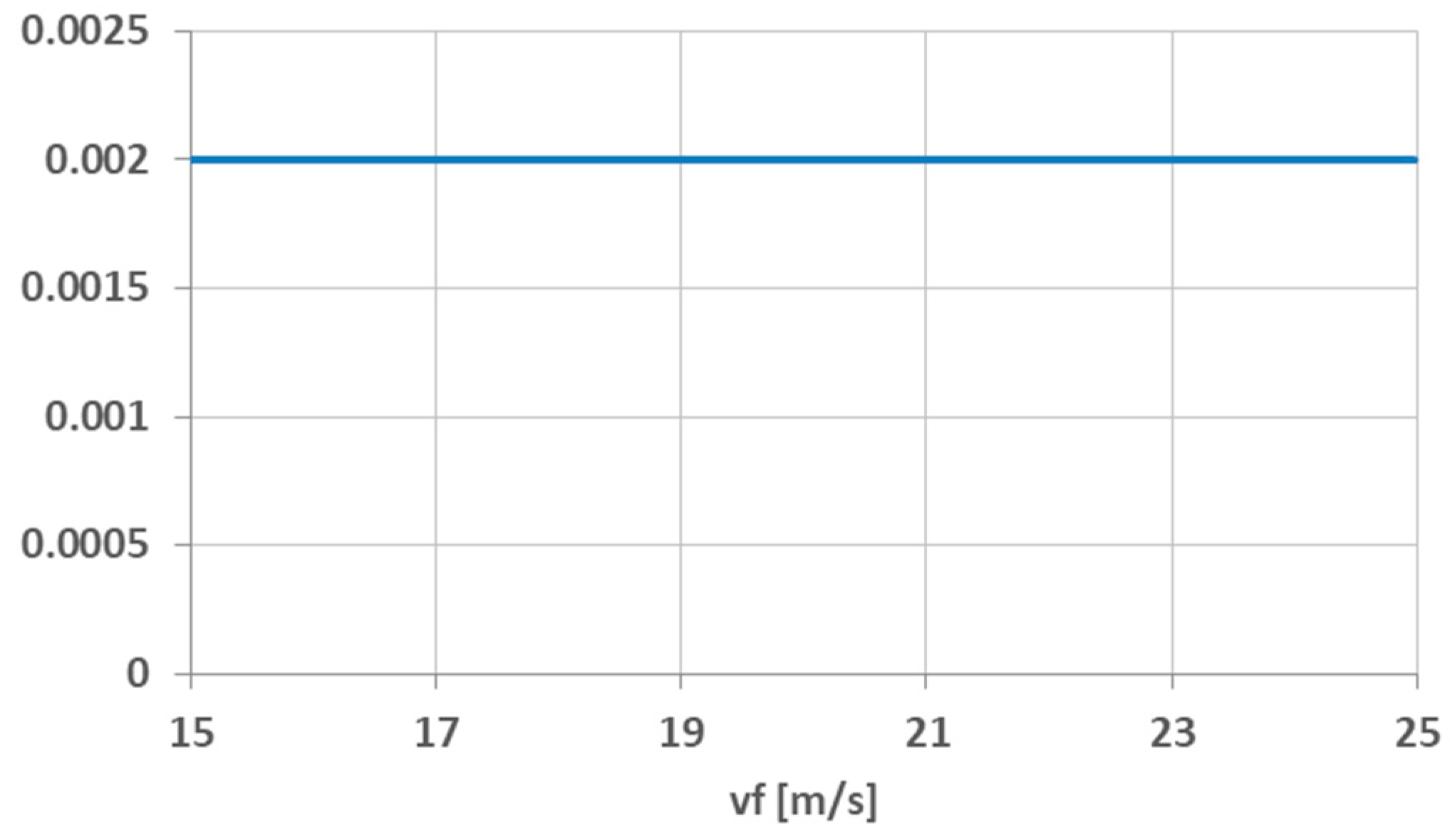
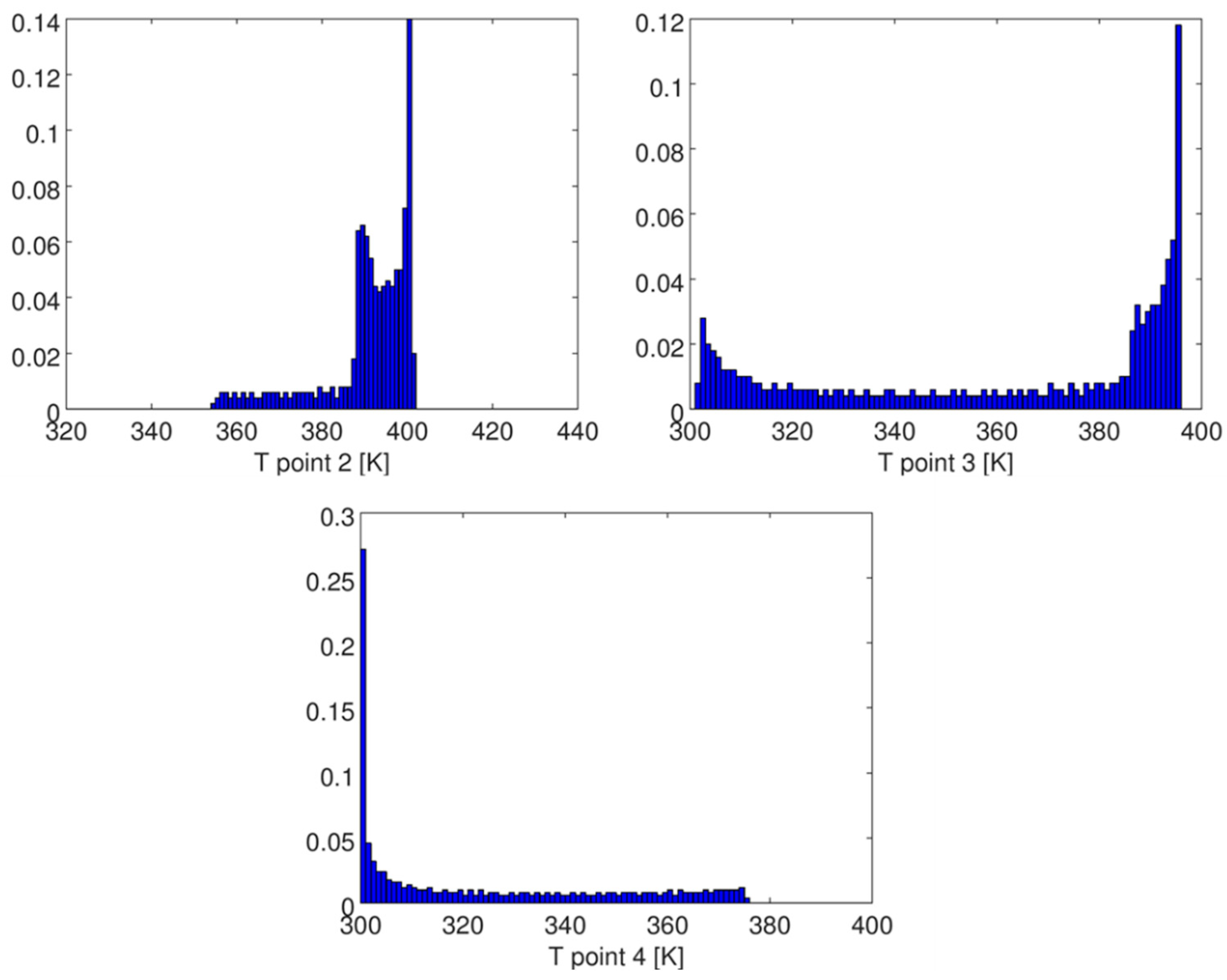

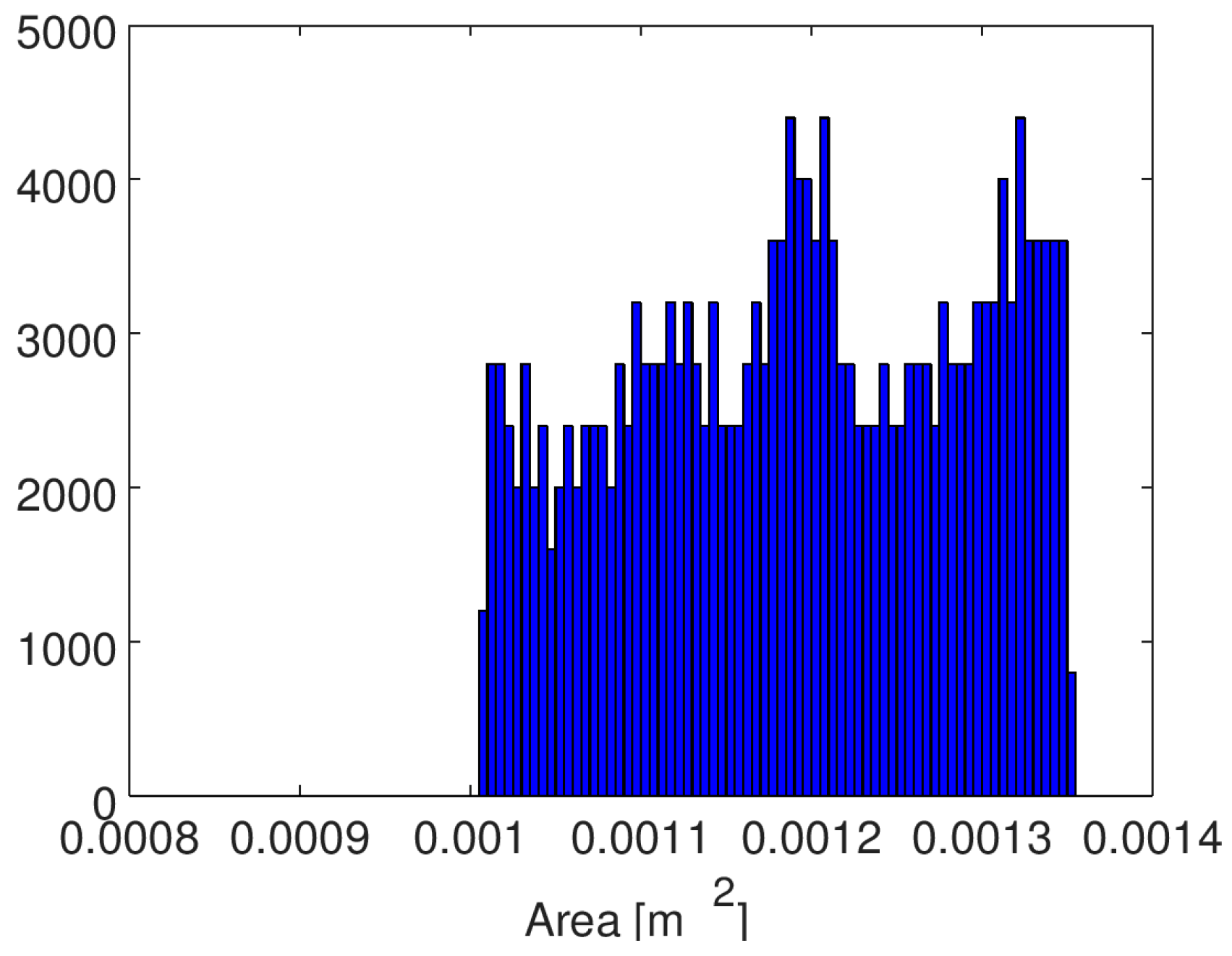
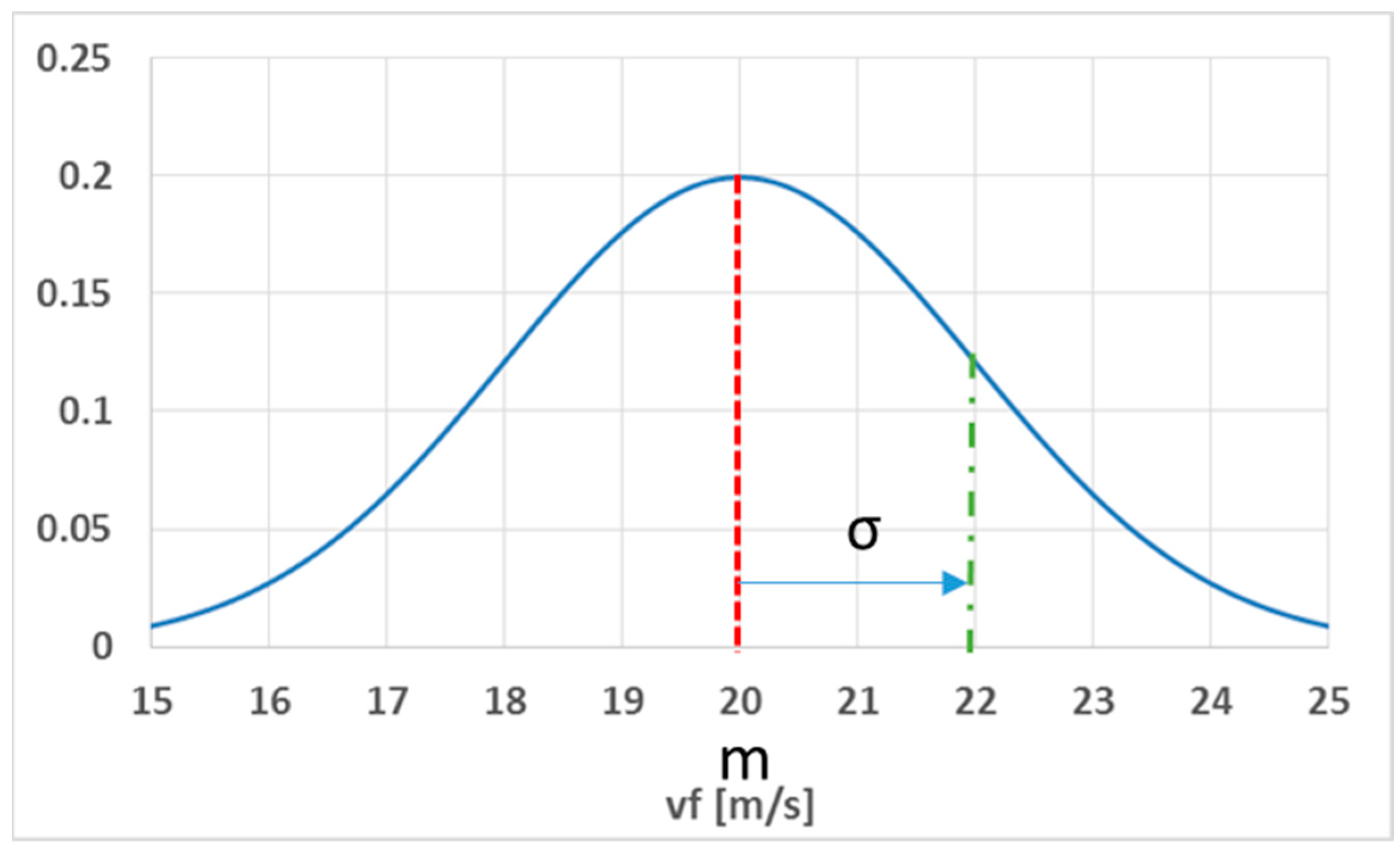
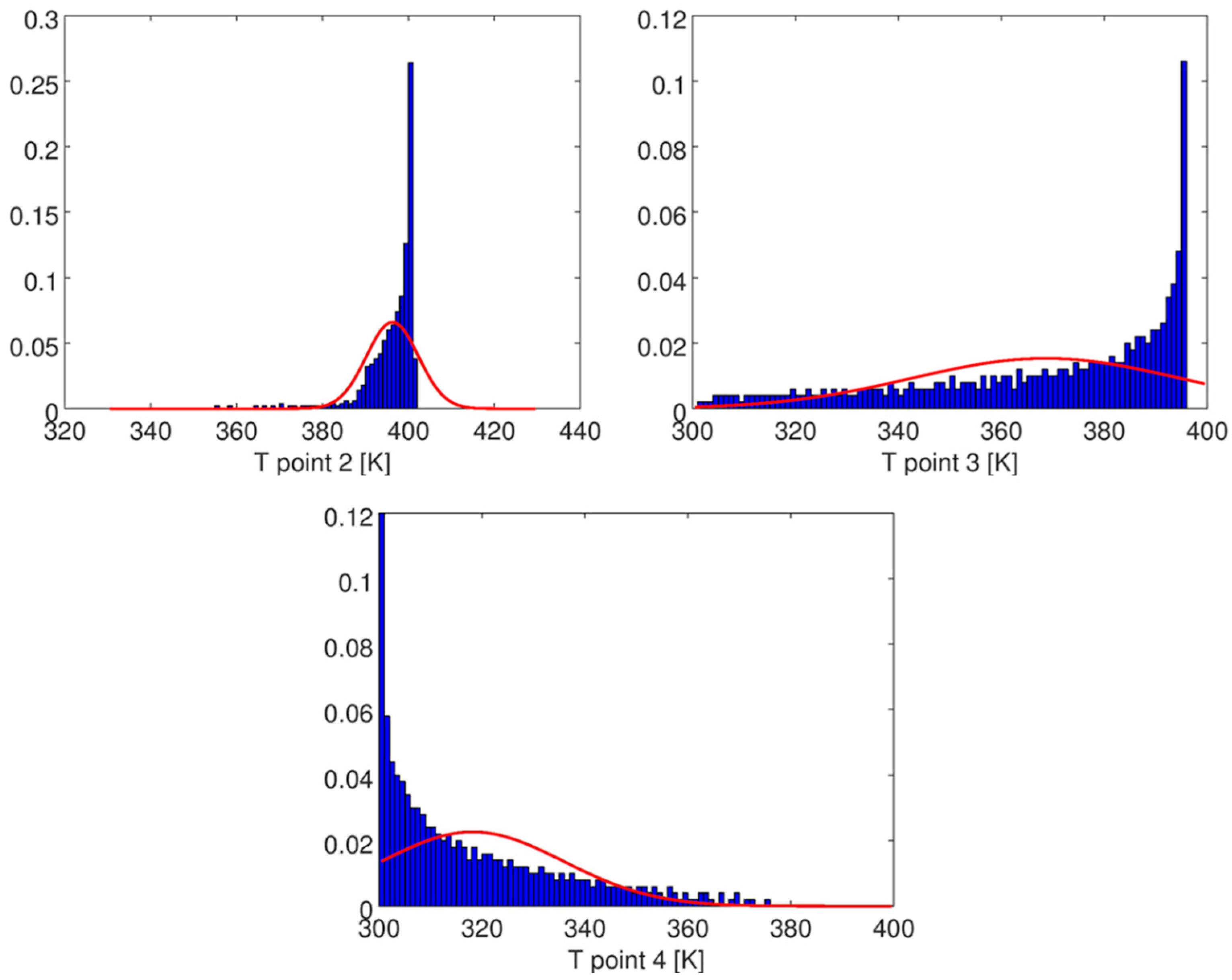
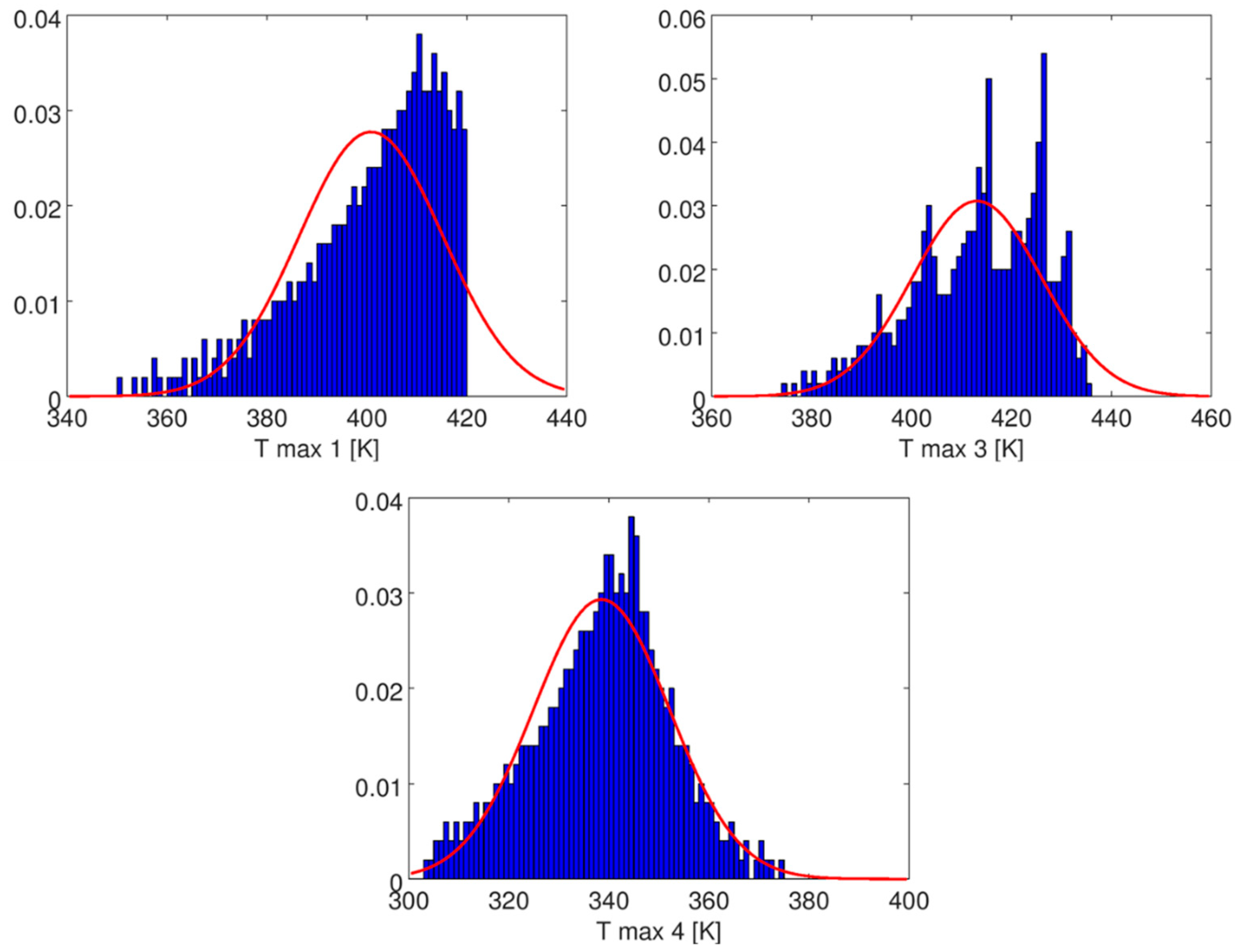

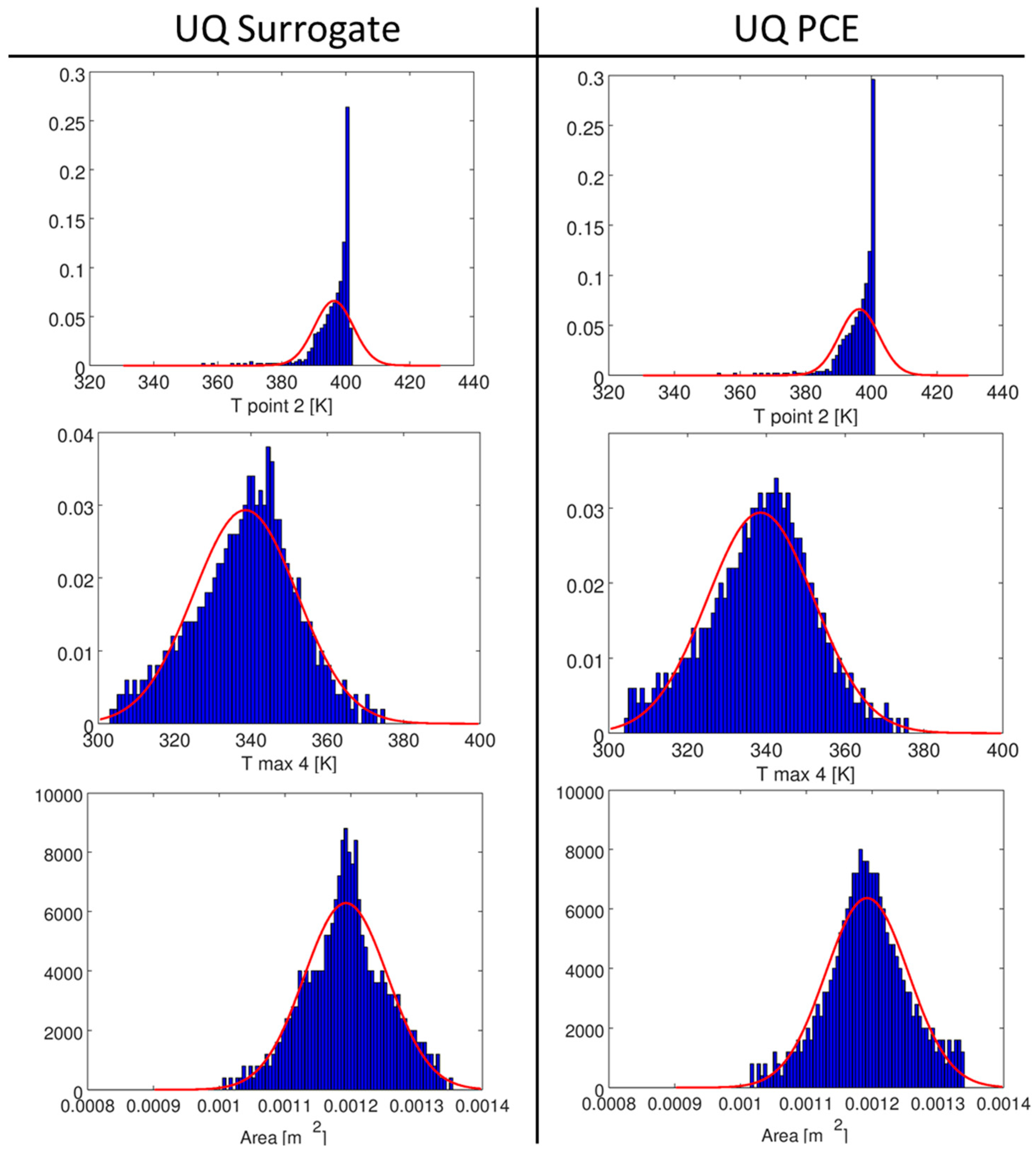
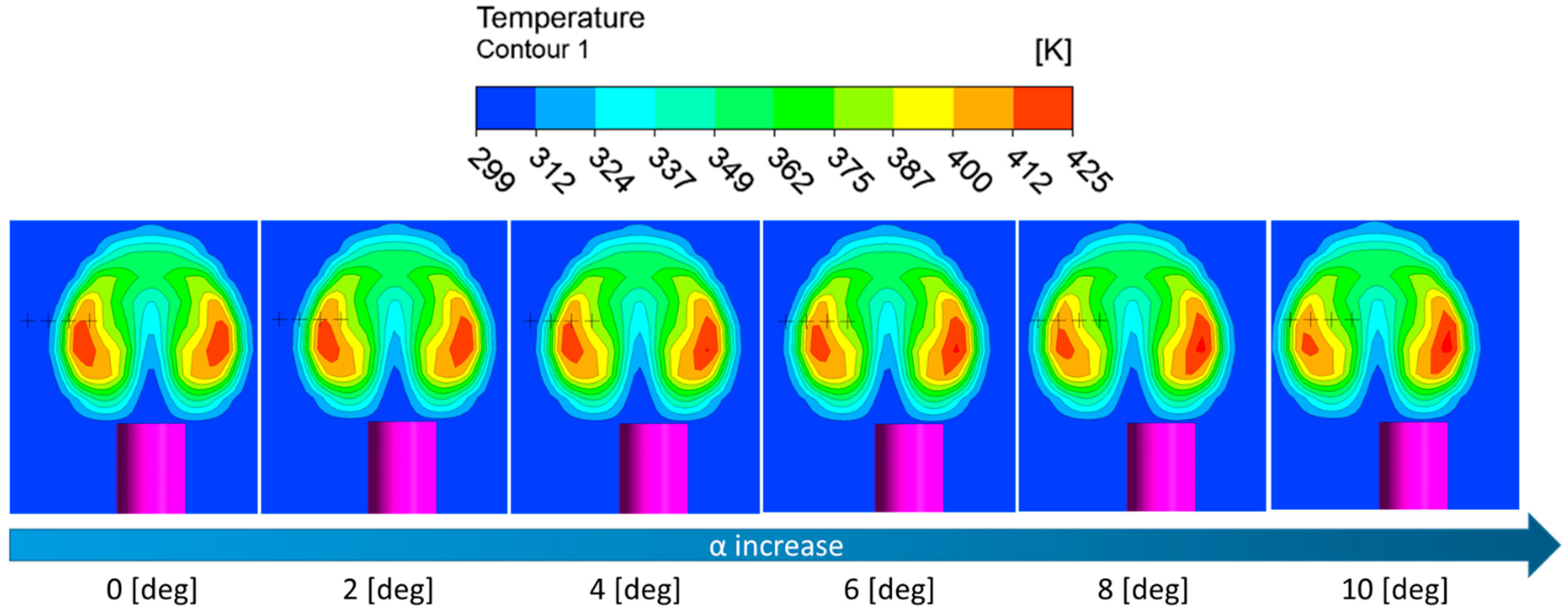
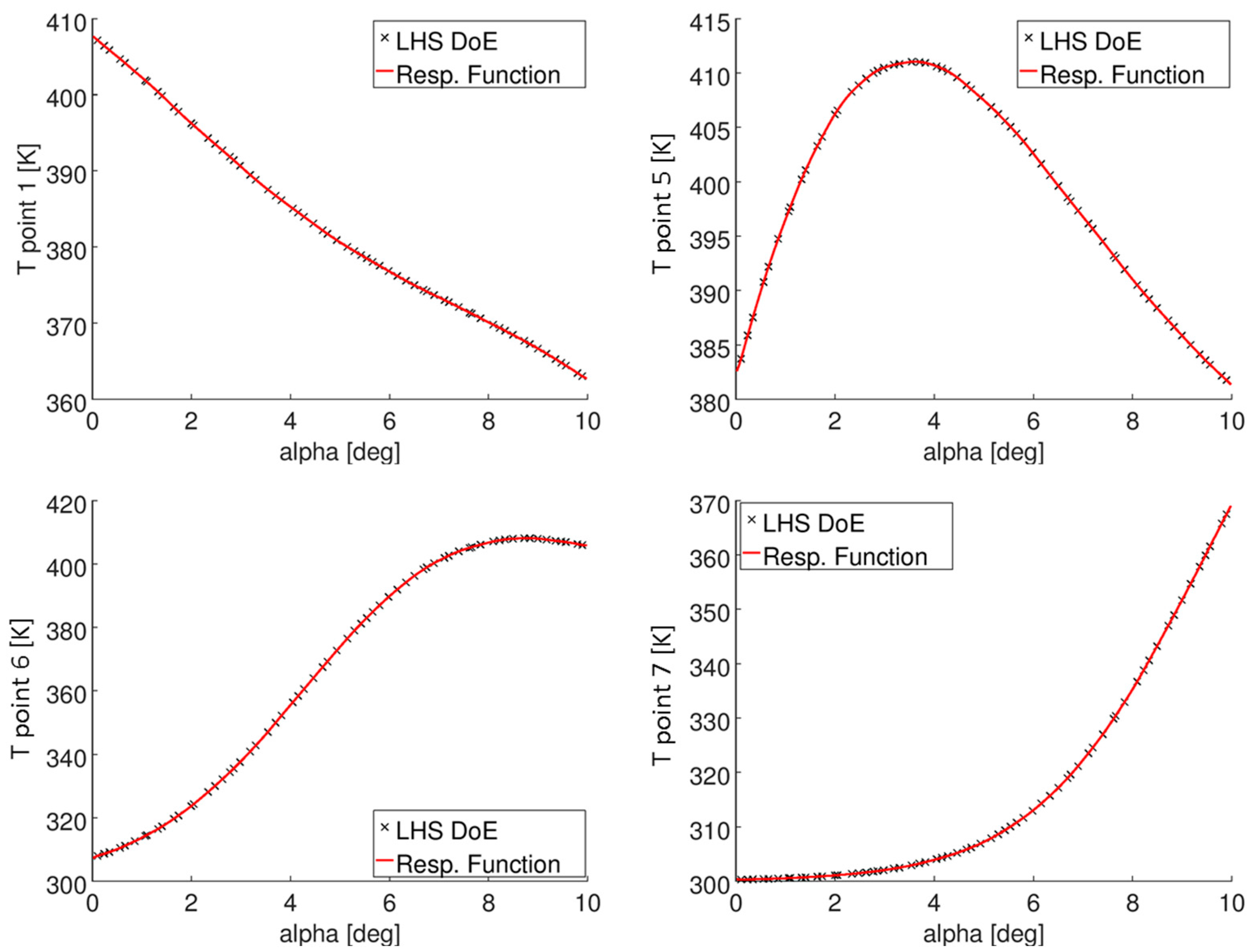
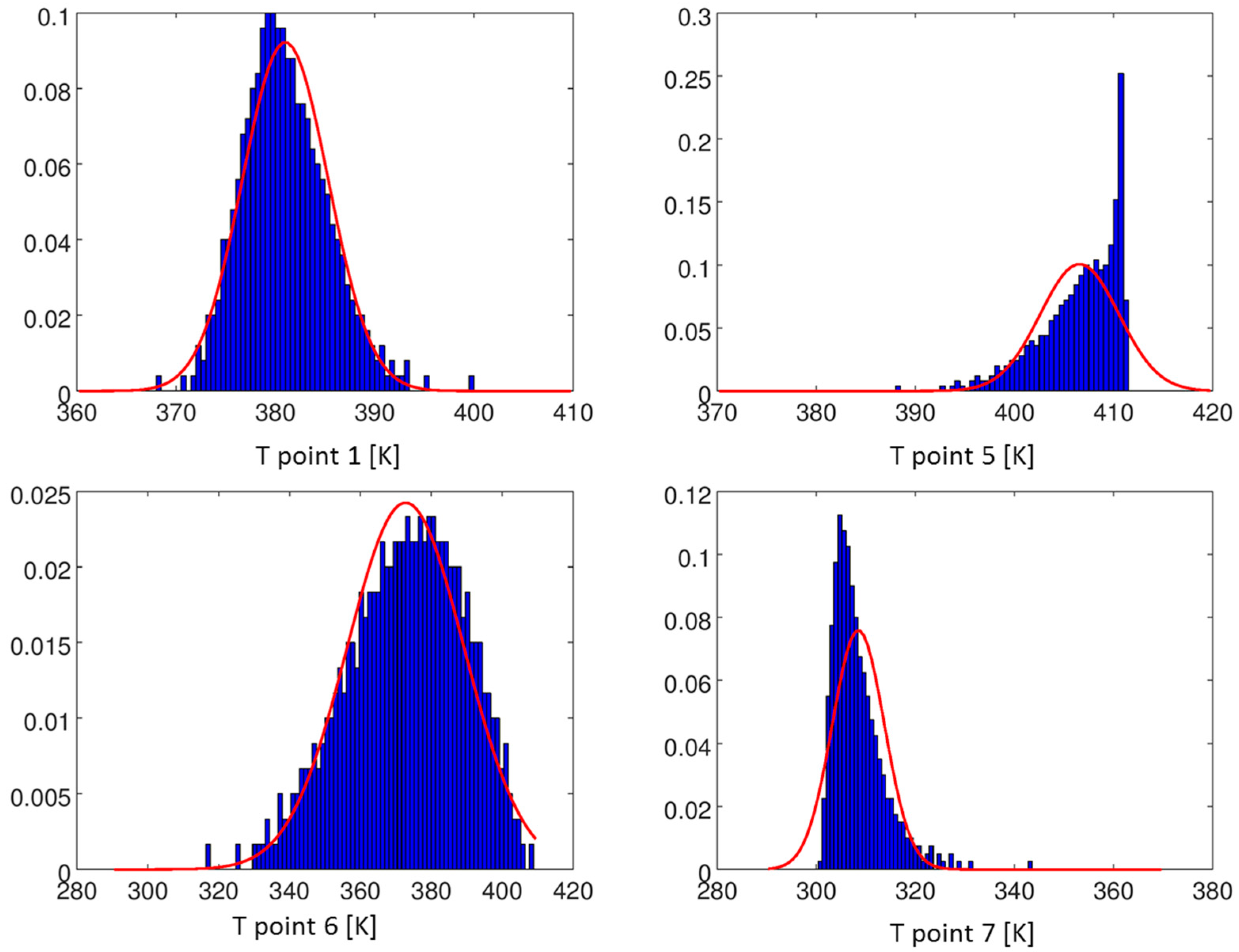

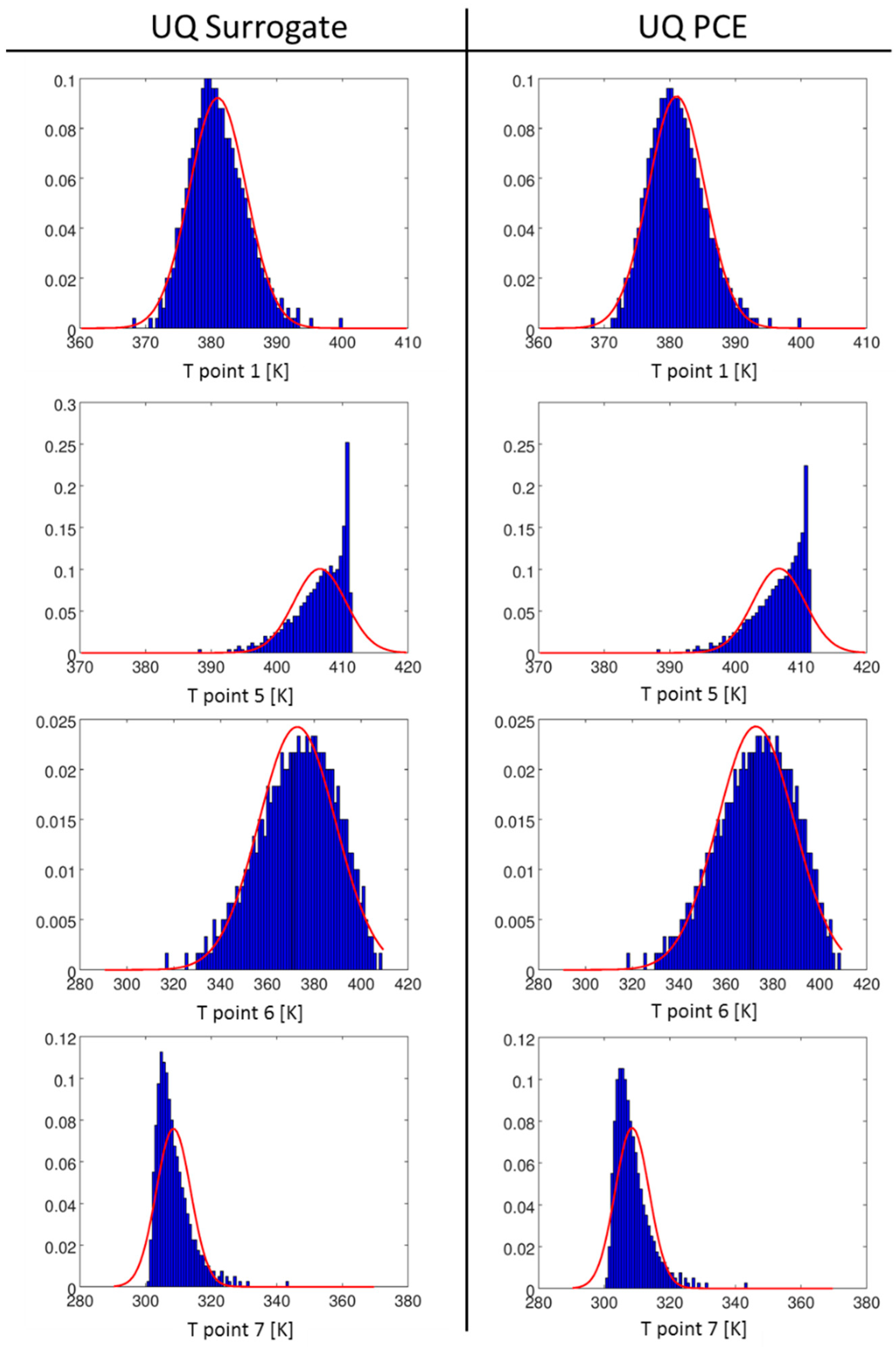
| Detection Point | X (mm) | Y (mm) | Z (mm) |
|---|---|---|---|
| Point 1 | 30 | 9 | 15 |
| Point 2 | 30 | 9 | 20 |
| Point 3 | 30 | 9 | 25 |
| Point 4 | 30 | 9 | 30 |
| Point 5 | 30 | 12 | 15 |
| Point 6 | 30 | 15 | 15 |
| Point 7 | 30 | 18 | 15 |
| Mean | σ | σ/m (%) | |
|---|---|---|---|
| Tmax,1 | 401 [K] | 14.3 [K] | 3.6 |
| Tmax,3 | 413 [K] | 12.9 [K] | 3.1 |
| Tmax,4 | 339 [K] | 13.6 [K] | 4.0 |
| Tpoint,2 | 396 [K] | 6.0 [K] | 1.5 |
| Tpoint,3 | 369 [K] | 26.0 [K] | 7.0 |
| Tpoint,4 | 318 [K] | 17.6 [K] | 5.5 |
| Area | 1.19 × 10−3 [m2] | 6.34 × 10−5 [m2] | 5.3 |
| m (K) | σ (K) | σ/m (%) | |
|---|---|---|---|
| Tpoint,1 | 381 | 4.3 | 1.135 |
| Tpoint,5 | 406.5 | 3.9 | 0.975 |
| Tpoint,6 | 372.7 | 16.4 | 4.414 |
| Tpoint,7 | 308.5 | 5.2 | 1.704 |
Disclaimer/Publisher’s Note: The statements, opinions and data contained in all publications are solely those of the individual author(s) and contributor(s) and not of MDPI and/or the editor(s). MDPI and/or the editor(s) disclaim responsibility for any injury to people or property resulting from any ideas, methods, instructions or products referred to in the content. |
© 2023 by the authors. Licensee MDPI, Basel, Switzerland. This article is an open access article distributed under the terms and conditions of the Creative Commons Attribution (CC BY) license (https://creativecommons.org/licenses/by/4.0/).
Share and Cite
Cravero, C.; De Domenico, D.; Marsano, D. Uncertainty Quantification Analysis of Exhaust Gas Plume in a Crosswind. Energies 2023, 16, 3549. https://doi.org/10.3390/en16083549
Cravero C, De Domenico D, Marsano D. Uncertainty Quantification Analysis of Exhaust Gas Plume in a Crosswind. Energies. 2023; 16(8):3549. https://doi.org/10.3390/en16083549
Chicago/Turabian StyleCravero, Carlo, Davide De Domenico, and Davide Marsano. 2023. "Uncertainty Quantification Analysis of Exhaust Gas Plume in a Crosswind" Energies 16, no. 8: 3549. https://doi.org/10.3390/en16083549






